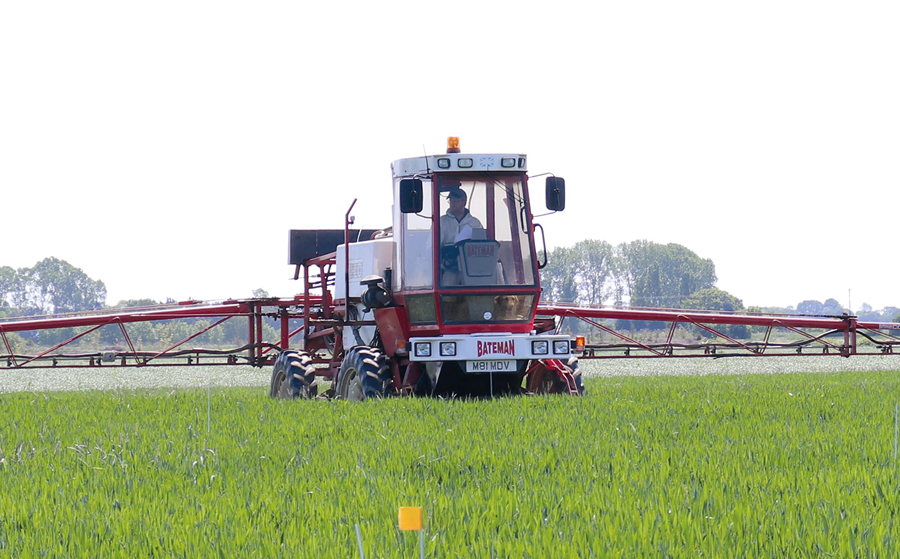Wins all round from water volume trials
19th March 2020
Optimum fungicide performance can be achieved at lower water volumes, providing you make the right choices when it comes to nozzle type and sprayer set up.
Optimum fungicide performance can be achieved at lower water volumes, providing you make the right choices when it comes to nozzle type and sprayer set up.
A two-year project between Bayer and application specialist Tom Robinson has shown what’s possible when it comes to using decreased water volumes. Mr Robinson evaluated nozzle and fungicide performance at lower water volumes and measured effective fungicide performance through reducing disease and increasing yield.
Many operators have a tendency to opt for higher water volume in the belief that it improves target coverage, especially where canopies are lush. But that isn’t the case providing good practice is adhered to.
Another reason for the trial is Mr Robinson’s belief that field trials with farm equipment are the best way of evaluating fungicide performance. “Development trials and label recommendations are based on small plots, handheld applicators and a speed of 3.6km/h. It just isn’t reflective of what we do in the field,” he notes.
Mr Robinson conducted application trials at GS39 (T2), using October-drilled KWS Kerrin feed wheat and fungicides AscraXpro (prothioconazole + bixafen + fluopyram), Elatus Era (prothioconazole + benzovindiflupyr) and Librax (metconazole + fluxapyroxad). The sprays were applied by Green Bank Agriculture with a Bateman self-propelled sprayer. Interestingly, septoria tritici wasn’t the principal disease in both seasons. In 2018, brown rust was the greater threat.
The trials highlighted the importance of nozzle choice and sprayer set up at lower water volumes. In this trial, all fungicides performed best when applied using Guardian Air AI nozzles – the pick of the plots being Ascra at the 1.2-litre/ha rate. “The highest mean yield from two seasons of data was the combination of Guardian Air AI nozzle and Ascra, which was over 10.5t/ha. That’s 0.5t/ha better than some SDHI fungicide options, and more than 1.0t/ha over untreated,” he explains.
The trials confirmed what Mr Robinson already suspected – a yield improvement with AI nozzles. “In these trials we’ve seen an average yield difference of 0.5t/ha between the Guardian Air AI nozzle and flat fan alternatives at 100-litre/ha. The best spray operators are already getting the required disease control needed at the lower recommended water volume rates, but the reality is everyone can.”
For him it’s a win-win situation. “Not only are you getting effective disease control and yield response, but also at least a 50 per cent reduction in drift and treating up to a third more area from
a single tank.”
Mr Robinson says the ability to cover a greater area is an important one. He points out that for every day you delay T2 applications beyond GS39 you can lose 0.1t/ha. “Treating your entire wheat area accurately is the goal. But catchy weather can arrive any time of the year so the more field efficient you are the greater the chance of adhering to timing accuracy.”
Two reasons for the better performance of the Guardian Air AI nozzle are its improved spray protection and penetration of the lower canopy, he adds. “The T2 is about flag leaf protection, but protection for leaves two and three is welcome, too. These are also contributing to yield, so keeping them clean is useful. At GS39 the majority of spray deposit will be directed at the flag leaf, but 25 per cent is likely to hit leaf two and 12.5 per cent leaf three. Previous trials have shown that reducing the water volume from 200-litre/ha to 100-litre/ha increases the amount of product deposited on the crop.”
Care with nozzle selection also has to be matched with sprayer set up. Mr Robinson stresses the importance of boom height and nozzle uniformity. “If you’ve imbalance in boom height, then disease control is bound to be compromised. Boom height shouldn’t be above 50cm from the crop and needs to be maintained across boom width. Nozzles need to be adjusted so that each is giving an equal spray volume and pattern. The extra time in setting up the sprayer correctly will pay off in better disease control and yield,” he says.
Furthermore, he only recommends nozzles with tolerances of plus or minus 2 per cent. Nozzles with higher tolerances only give a less defined pattern, especially when they wear, he warns. He would also reduce boom height if enhanced disease control is needed on leaves two and three at the T2 timing. His suggestion to get more fungicide on these leaves is to reduce boom height to 40cm.
Bayer’s Jennie Watson feels one reason Ascra performed so well in the trial is down to its Leafshield formulation. “Even with flat fan nozzles, Ascra still performed extremely well, and there was greater consistency with Ascra regardless of nozzle choice compared to other SDHI fungicides.”
Bayer has always claimed that its Leafshield formulation provides excellent leaf adhesion and spread, and work with Silsoe Spray Applications Unit has confirmed this. They conducted droplet spread tests with a range of SDHI fungicides, and after just two minutes Ascra had covered far greater leaf surface than the others. By five minutes those differences remained.
The benefit is improved disease control, yield response and consistency, says Mrs Watson. “Clearly to nullify disease threats and maintain green leaf area then it’s about optimum coverage of the target leaf.
The better a fungicide can travel over and into leaves, the better control you will achieve. But Xpro fungicides have proven to be rainfast remarkably quickly, and again this is down to leaf adhesion and spread. Reliable fungicide performance is a great added value extra when catchy conditions exist,” she concludes.

